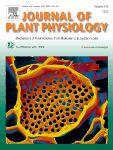Ver ítem
- xmlui.general.dspace_homeCentros e Institutos de InvestigaciónCIAP. Centro de Investigaciones AgropecuariasInstituto de Fisiología y Recursos Genéticos VegetalesArtículos científicosxmlui.ArtifactBrowser.ItemViewer.trail
- Inicio
- Centros e Institutos de Investigación
- CIAP. Centro de Investigaciones Agropecuarias
- Instituto de Fisiología y Recursos Genéticos Vegetales
- Artículos científicos
- Ver ítem
Elongation growth in leaf blades of Chloris gayana under saline conditions
Resumen
In Chloris gayana, salinity-associated yield decreases are due mainly to leaf area reductions. To understand the physiological basis for such reduction, the effects of salinity were studied on the spatial and temporal distribution of extension in the intercalary meristem at the leaf base, and on hydraulic conductance in that zone. C. gayana plants were grown on sand irrigated with Hoagland solution with the addition of 0 or 200 mmol/L NaCl, and all
[ver mas...]
In Chloris gayana, salinity-associated yield decreases are due mainly to leaf area reductions. To understand the physiological basis for such reduction, the effects of salinity were studied on the spatial and temporal distribution of extension in the intercalary meristem at the leaf base, and on hydraulic conductance in that zone. C. gayana plants were grown on sand irrigated with Hoagland solution with the addition of 0 or 200 mmol/L NaCl, and all measurements were performed on tiller leaf four. In salinised plants, that leaf was 20 percnt; shorter than in controls. Extension in the blade expansion zone was studied by pricking through the leaf sheaths and analysing the displacement of the pricks. In salt-treated plants, maximum growth rates were depressed by 53 percnt; and the growth zone was shorter by approximately 10 mm, nevertheless, extension proceeded for a longer period than in control plants. The analysis of specific leaf areas in the expansion zone suggests the rate of dry matter deposition was lowered by salinity and estimations of tissue displacement time within that zone suggest cell wall maturity was delayed. Hydraulic conductance was reduced by salinity and this may be the main cause for reduced growth under salinity in Chloris gayana.
[Cerrar]

Fuente
Journal of Plant Physiology 160 (5) : 517-522 (2003)
Fecha
2003
Editorial
Elsevier
ISSN
0176-1617
Formato
pdf
Tipo de documento
artículo
Palabras Claves
Derechos de acceso
Restringido
 Excepto donde se diga explicitamente, este item se publica bajo la siguiente descripción: Creative Commons Attribution-NonCommercial-ShareAlike 2.5 Unported (CC BY-NC-SA 2.5)
Excepto donde se diga explicitamente, este item se publica bajo la siguiente descripción: Creative Commons Attribution-NonCommercial-ShareAlike 2.5 Unported (CC BY-NC-SA 2.5)

